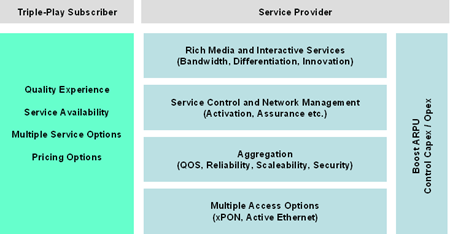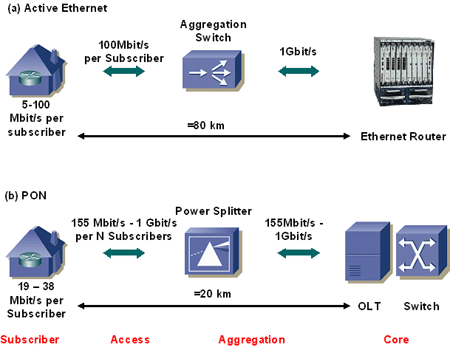Назад в библиотеку
Ethernet FTTH Triple-Play Services
by Tim Hills
Ссылка на оригинал.
Rapid advances in technology are opening the door to an expanding array of residential services under the Triple-Play banner – which is boosting competition as incumbents, cable MSOs, competitive carriers, and ISPs trespass onto each others’ turf and battle over subscribers.
Intense competition will require all these players to develop business processes and more intelligent networks that make them highly adaptable to change and more responsive to customer demands. And that means Ethernet – the base on which triple-play will be built – will have to raise its game.
To be successful, service providers will require:
- Increased flexibility in speeding services to market
- QOS for IPTV and VOIP applications
- Strong multicast performance for IPTV
Fortunately, new, higher-performance Ethernet access, aggregation, and service management platforms are becoming available that enable operators to deliver FTTH (fiber to the home) triple-play services successfully. This report, which meshes with the earlier reports such as PON & FTTx Update and Handling Broadcast IPTV Content, looks at key requirements and how Ethernet systems can handle them.
Webinar
This report is based on a Webinar, Using Metro Ethernet to Deliver FTTH Triple-Play Services, moderated by Stan Hubbard, Senior Analyst, Heavy Reading, and sponsored by Brix Networks Inc. , Extreme Networks Inc. (Nasdaq: EXTR), PacketFront AB , and Riverstone Networks – now part of Lucent Technologies Inc. (NYSE: LU). An archive of the Webinar may be viewed free of charge by clicking here.
Figure 1 highlights key FTTH triple-play requirements from the standpoint of the subscriber and the service provider.
Figure 1: FTTH Triple-Play Requirements for Subscriber & Service Provider

Source: Light Reading, 2006
On the subscriber side, consumers will demand a quality experience. According to Gary Holland, Senior Manager, Carrier Ethernet Marketing for Lucent Technologies Inc. (NYSE: LU), in triple-play every user is a network monitor.
“If a network glitch causes slight pixelization during a football game, a subscriber might find it a bit annoying,” he says. “But if a network outage or excessive pixelization causes our fan to miss the winning goal, then phones start ringing at the service provider’s customer service center, and the possibility of subscriber churn becomes a reality.”
So networks have to run flawlessly, with hiccups corrected in a timely manner. Consumers also are looking for triple-play service availability wherever they live, and they want to have a multitude of service and pricing options.
On the service provider side, everyone is focusing on ways to increase ARPU (average revenue per user) while controlling capital and operational costs as their subscriber bases grow. Key requirements here break down into four general areas:
- The arrival of rich-media and interactive services is driving new demands on network access and infrastructure. This includes the ability to deliver more bandwidth, differentiate service offerings, and rapidly innovate and bring services to market before – or at least in line with – the competition.
- Strong service control and network management are needed. Heavy Reading surveys of operators indicate this is one of their top Ethernet-related priorities in 2006. Among other things, this is about the ability to rapidly activate services, provide service assurance, and efficiently maintain and operate networks.
- Strong QOS, reliability, scaleability, and security features are needed at the aggregation level.
- Carriers are looking for multiple access options, such as PON and active Ethernet.
Underlying all these requirements, of course, is the availability of lots of subscriber bandwidth. But just how much is "lots"? The question is important to triple-play, because different technologies have different bandwidth limitations, and the business/technology tradeoffs become complex and difficult.
Unfortunately, no one knows yet, and discussions can easily spin off into how many gigabits per second would be needed to support 3D life-size holograms for full-immersion interactive gaming and the like. More modestly, something like the following might be plausible during the next decade for a heavy-use home with multiple users/channels active simultaneously:
- E-mail/Internet: 8 Mbit/s
- High-Definition Triple Play: 38 Mbit/s
- HIgh-Definition Gaming: 19 Mbit/s
- High-Definition Videophone: 19 Mbit/s
- TOTAL: 84 Mbit/s
While much of this will be downstream bandwidth, the upstream bandwidth will still be substantial in applications like video gaming, peer-to-peer uploading, and so on.
For Ethernet FTTH-based triple-play the basic access technology choice for service providers seems to be between active Ethernet and one of the various forms of passive optical network (PON). Although PONs began years ago as ATM-based systems, the more-recent standards support Ethernet. Figure 2 illustrates the general picture of these two approaches to FTTH Ethernet.
Figure 2: Active Ethernet & PON Are FTTH Alternatives

Source: Riverstone Networks, 2006
Active Ethernet has dedicated subscriber bandwidth and active outside plant using low-cost Ethernet components. The subscriber connects typically over a 100-Mbit/s Ethernet connection to an Ethernet aggregation switch, which is connected in turn over Gigabit Ethernet to an Ethernet router.
In contrast, a PON uses non-powered optical splitters/combiners that allow a single fiber run to serve multiple subscribers – typically up to 32, but sometimes up to 64. This basically broadcast-like mode of operation means that the available bandwidth is shared among subscribers, giving useful bandwidths typically between 19 and 38 Mbit/s per subscriber. The fiber is typically terminated in the subscriber’s home by an optical network unit (ONU), connected by an optical splitter to the optical line terminator (OLT). The OLT is connected to the switch (ATM or Ethernet), and the switch connects into the service provider’s active network.

